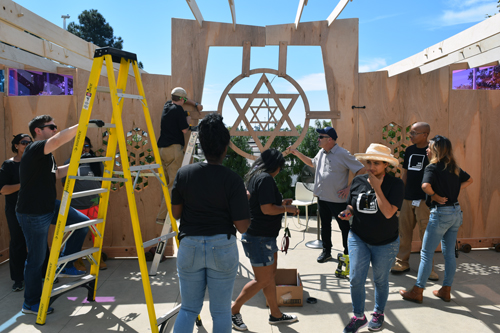
By Donald H. Harrison
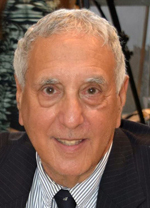
SAN DIEGO – The temporary structures, or sukkahs, in which Jews celebrate the holiday of Sukkot typically are thrown up by Jewish families or congregations to partake in celebratory communal meals and to welcome strangers to our community.
However, the sukkah just recently built at the Jewish Family Service (JFS) campus on Balboa Avenue is anything but typical. To begin with, it was “strangers,” not Jews who built it – the design and construction team was comprised of non-Jewish students earning six academic credits from San Diego’s NewSchool of Architecture and Design.
Carole Yellen, coordinator of the project, told this interviewer, “The reason we wanted to build a sukkah is that Sukkot is one of the holidays which is about bringing our community in, whether neighbors or strangers. The sukkah is built so that it is very open, out in nature. Sukkot is a harvest festival so it is about sharing our resources.
“So the holiday of Sukkot is about welcoming strangers as guests, and we (JFS) are all about being part of our community and bringing people in on a consistent basis. I think the sukkah also has the dichotomy of being very vulnerable and fragile, and so we recognize that in our own lives and in the lives of our clients. Things are not always permanent, and yet there is a strength to it as well. It can’t be so flimsy that it is going to blow over in the wind, yet it is really meant to be temporary. The temporariness reminds us of the farmers who would go out for the harvest and set up a hut … and it also reminds us of when the Jews fled Egypt and wandered in the desert for 40 years.
“So, I think it is important for JFS to have this as a symbol of our being able to welcome the community in—as we do all year long in different ways, whether it is the Corner Market and sharing the food which we have there with families who are in need, or welcoming the stranger, refugee, or immigrant as they are fleeing persecution as well.”
Another way in which JFS welcomes the stranger is by permitting homeless people who live in their cars to park overnight in their secure parking lot. Restroom facilities are made available along with food from the Corner Market.
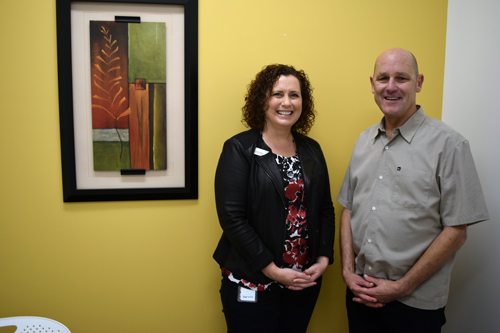
After learning about the mission of JFS, as well as the history and rules of these temporary dwellings, the students individually drew or made models illustrating their ideas of what a sukkah could look like, and then made presentations to a JFS panel that included lay members and Rabbi Shai Cherry.
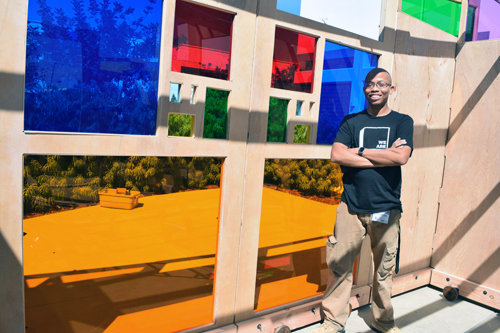
The selection panel selected one sukkah designed by Noura Bishay, an Egyptian Christian woman whose family farm is in the Sinai Desert. The panel also was particularly impressed by a pair of panels each adorned with seven acrylic windows in different colors recommended by student John Sanders III of the Houston, Texas, area. The selection panel arranged for the colorful windows to be incorporated into Bishay’s design. Sanders family, incidentally, survived in good health the ravages of Hurricane Harvey, although an outdoor storehouse of theirs was flooded – an example, said Yellen, of the fragility of life symbolized by the sukkahs.
The Bishay-Sanders hybrid sukkah tells through the elements of architecture at least two stories. There are seven of Sanders’ brightly colored rectangles in recognition of the fact that, according to his research, Sukkot is the seventh major Jewish holiday of the secular year (preceded by Purim, Pesach, Shavuot, Tisha B’Av, Rosh Hashanah, and Yom Kippur), “occurring in the seventh month of the year, the seventh full moon, and last seven days.”
Bishay’s sukkah, measuring approximately 15 feet by 20 feet, celebrates the 19th-Century English rhyme of what a bride should wear at her wedding: “Something old, something new, something borrowed, something blue.”
Some things old were the antique industrial sewing spindles that the students converted into wheels for moving the portable sukkah.
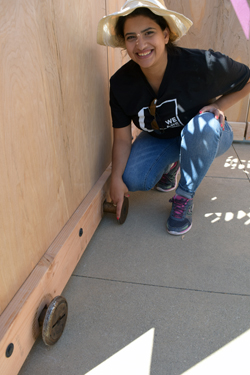
Some things new are the plywood panels of the sukkah.
Something borrowed were designs from the Middle East that were laser cut into the walls of the sukkah.
And something blue was one of Sanders’ seven acrylic rectangles.
Although no weddings are scheduled in the sukkah, the theme, like a wedding, is one of community and celebration as well as spirituality.
“It is a blessing to have a place to pray and thank God,” commented Bishay, who noted that some people in her native country might criticize her because they see Jews and Israel as enemies. However, “I am not worried about that as much as I am passionate about a place where you can thank God, and where all religions can come to, and have a moment when we can reflect on how fragile the sukkah can be and at the same time we are fragile,” Bishay said. “It is a very spiritual place.”
Another key participant in the process was Sarah Cabana, who unlike the dozen other students involved with the project is studying construction management and not architecture. After serving in the Navy, where she worked on helicopters, Cabana joined Paragon Builders in El Cajon. They started her as a bookkeeper, but she yearned to return to hands-on work, so now is studying at the NewSchool of Architecture and Design.
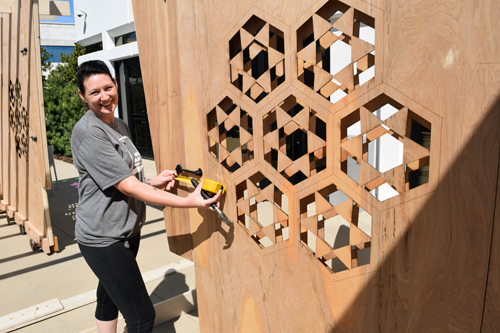
Because the class taught by Associate Professor Chuck Crawford also was designing and building a set of four sukkahs to be utilized at the Coastal Roots Farm on the Leichtag Foundation property in Encinitas, one of the most difficult parts of the assignment was “keeping the materials separate, and keeping track of which projects everyone was working on.”
The JFS project and the Leichtag project are completely different, said Cabana.
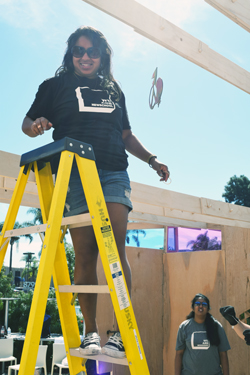
Dilini Perera, whose design was chosen for the Leichtag project, explained that at Leichtag, the objective was to be able to accommodate as many as 1,000 people for a celebration. To do so involved designing four separate sukkahs to be placed at the corners of a central space, with each sukkah being symbolic of one of the Four Species used in the celebration of Sukkot – etrog (citron), lulav (date palm frond) , hadass (myrtle branch and leaves), and aravah (willow branch).
The etrog booth has a “dome-like structure made from pipes and canvas” representing the large green fruit. The lulav booth folds out like a date palm tree. The hadass booth has cutouts of the myrtle leaf, while the aravah booth has a wall that is “divided into little squares with willows and moss” according to Perera.
Each of the four booths measure approximately 12 feet by 12 feet.
The JFS sukkah offered a challenge to the students that was not specified by the Leichtag Foundation, which has been commissioning sukkah booths for the last five years.
JFS asked that the booth be designed in such a way that it could be taken down, rolled into storage, and used again year after year.
Both projects needed to follow halachic rules for buildings sukkahs – such as each structure needed to have at least 2 ½ walls, provide more shade than sun, provide a good view to the stars, be strong enough to withstand wind, but not be permanent, and should have only natural materials, nothing artificial, on the roof, according to JFS’s Yellen.
“That meant that for the roof, they used wooden pegs, no metal, for example,” she said.
Besides Bishay, Sanders, Cabana and Perera, students who built the JFS sukkah on Friday, Sept. 29, included Cynthia Morose, Sovanary Phy, Marlena Jackson, Madhevi Nataravan, Veena Ravi, Firas Alrakhayes, Samia Kher, Adam Peltier and Nic Coffman.
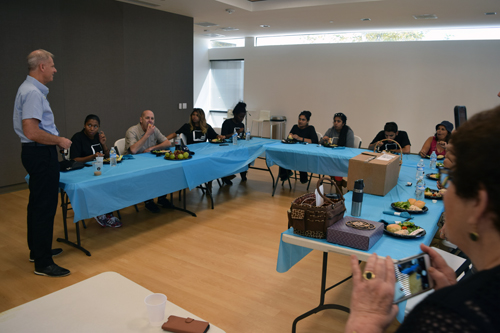
JFS Chief Executive Officer Michael Hopkins thanked the students during a lunch break at which they sampled food prepared in JFS’s Loonin Family Kitchen, where, according to a spokesperson, “more than 84,000 healthy, kosher meals are prepared each year and hand-delivered to JFS clients through the Foodmobile — which brings these meals and a caring connection to homebound older adults and younger adults with disabilities — and to JFS’s Social and Wellness Centers for older adults.”
Hopkins quipped that he was pleased that the sukkah can again be used next year, “assuming we can figure out how to put it together!”
“I think you did an amazing job capturing a number of essential aspects: the value of the sukkah and the value of ritual, and the rules for building it …” He complimented the acrylic colors “that represent the diversity of your class and the diversity of the community as well. And you did it on time and on budget!”
Susan Cohn, coordinator of the Jewish Big Pal program, commented that Jewish youngsters and their Big Pals will help to decorate the sukkah along with older adults who meet on weekdays at the JFS campus.
“On Sunday (Oct. 1) we will have children and their families to decorate the sukkah,” she said. “Our staff will be in the sukkah having lunch every day … Our seniors will have opportunities to enjoy the sukkah during the course of the day. … This is very far reaching in terms of our staff, clients and the whole community. What you have done is a real mitzvah, fulfilling a commandment to do an act of loving kindness.”
*
Harrison is editor of San Diego Jewish World. He may be contacted via donald.harrison@sdjewishworld.com